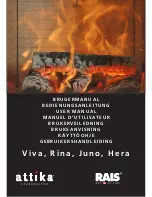
17
Vermont Castings Vigilant
®
2000898
IMpoRTaNT:
Do not hurry this part of the burn. Inad-
equate preheating of the chimney system is the most
common cause of poor coal stove performance.
NoTe:
The cast iron plates in your Vigilant will “season” as
they heat and cool over a period of time. The thermal shock
of very rapid temperature changes can cause the cast iron
to crack. NEVER build a roaring fire in a cold stove.
4. Add a moderate layer (1” - 2” ) of coal. When this is
burning well, indicated by a blue flame just above the
first layer, you may add coal layer by layer. Be sure each
new layer is burning well before adding the next layer.
CaUTIoN: hot while in operation. keep children,
clothing, and furniture away. Contact may cause skin
burns.
5. Coal may be loaded to the top of the front grill, and to
within one inch of the exhaust ports in the top of the
left and right side plates. Keep the coal level at least
an inch below the exhaust ports.
SaFeTy NoTe: Do not burn garbage or flammable
fluids such as gasoline, naphtha, or engine oil. Do not
use charcoal lighter fluid or any flammable liquid to
kindle or re-establish a fire in your coal burning stove.
also, never use self-starting charcoal briquettes. The
volatile gases given off by these materials when heated
may explode if ignited.
CaUTIoN:
Follow these instructions carefully to get the
safest, most efficient results with your stove. Failure to fol-
low these instructions may result in a dangerous chimney
or house fire.
Daily operation
Surface Thermometer
Use a surface thermometer to monitor stove perfor-
mance.
The Vigilant’s surface temperature, determined by placing a
stove thermometer in the middle of the griddle, can provide
helpful information about how the stove is performing.
The normal range of operating temperatures is between
400° and 700° F, although temperatures slightly outside
of this range may be expected. However, if temperatures
ST698
Vigilant
surface therm
08/01
Surface Thermometer
ST698
Fig. 23
A stove thermometer can provide helpful information
about how the stove is performing.
go above 700° F for extended periods, decrease the air
supply (move the thermostat lever to the right) and slow
the fire to avoid overfiring.
When starting a new fire, or after re-loading the stove, leave
the damper open until the surface temperature reaches at
least 500° F. Do not close the damper on a fire before it
is well-established.
If the surface temperature drops below 400° F, revive the
fire by one of the following:
• Increase the air supply by moving the thermostat
lever to the left.
• Open the damper.
• Clear ash from the grates and empty the ash pan.
• Re-load the stove.
• Add a layer of untreated charcoal or nonself-starting
charcoal briquettes.
• If the coal needs to be re-ignited, try placing a small
amount of very dry, finely split kindling on top of the
coal bed. The heat produced by the burning kindling
will increase the draft, and the improved draft will
increase the air flow through the coal bed to create
better conditions for ignition.
Internal Damper
The internal damper provides operating flexibility
Operate the Vigilant with the damper open when starting
the fire, when re-building the fire after a long burn, or when
burning a small fire with moderate heat output. Close the
damper only after establishing a strong fire and a good
draft by burning the stove with the damper open.
Because installation characteristics vary, the time necessary
to establish a good draft may also vary, from approximately
5 to 30 minutes or more. Exterior chimneys are generally
more difficult to heat up, and may require the longest
period of time.
On large and/or outside chimneys, the damper may always
need to be open for the flue to be sufficiently warmed so
that it will support an adequate draft. Even if this is neces-
sary, the Vigilant will operate effectively.
Be sure to open the damper and run the stove for a few
minutes before opening either the griddle or the front doors.
This will direct extra heat to the flue to increase the draft,
and will clear exhaust gases from the baffle system. Do
not leave doors and griddle open simultaneously to avoid
having gases escape.
Reloading the Stove
Put on a small layer of fresh coal and allow it to catch before
clearing the grates of ash. Once the new coal is ignited,
shake the grates with full, steady strokes of the shaker
handle. Stop shaking when red coals cover the ashpan or
when you feel resistance. Using the slicer, clear ash from
between the bars of the front grill. Also, clear ash from












































